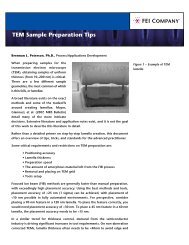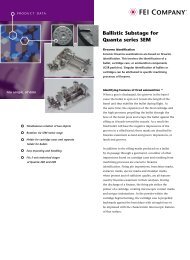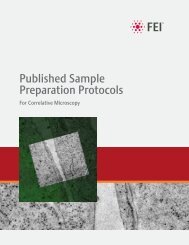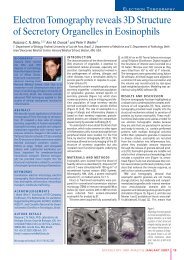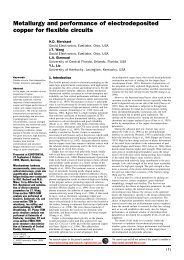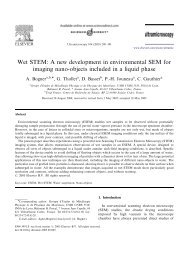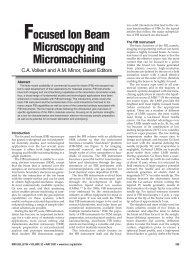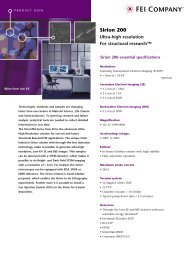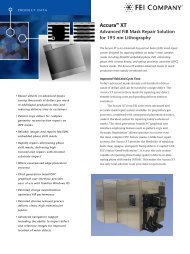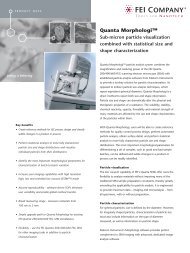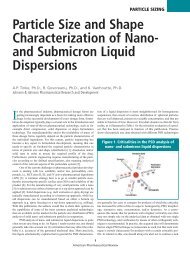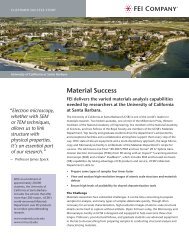Focused ion beam technology, capabilities and ... - FEI Company
Focused ion beam technology, capabilities and ... - FEI Company
Focused ion beam technology, capabilities and ... - FEI Company
You also want an ePaper? Increase the reach of your titles
YUMPU automatically turns print PDFs into web optimized ePapers that Google loves.
18<br />
Figure 49: SE image made with <strong>ion</strong> <strong>beam</strong> of<br />
catalyst covered ceramic balls. The use of FIB<br />
allows any individual particle to be selected<br />
<strong>and</strong> analyzed for industrial quality control. In<br />
this case the FIB has machined a TEM sample<br />
of the top surface. Time to result: 60 minutes.<br />
FIB systems deliver a single instrumental solut<strong>ion</strong> to enhance the speed <strong>and</strong> quality of the IC product<strong>ion</strong> process. The capability to perform<br />
design edits to the fabricated circuit ensures that the design <strong>and</strong> debug phase is limited to one mask step, <strong>and</strong> that extensive <strong>and</strong> expensive<br />
iterat<strong>ion</strong> steps can be avoided. The process control <strong>and</strong> failure analysis <strong>capabilities</strong> offered by FIB also provide the fastest possible route-cause<br />
data to shorten yield improvement cycles <strong>and</strong> solve site specific failure modes, either in the product<strong>ion</strong> process or on customer returns.<br />
On-Chip<br />
Circuit Editing<br />
Precis<strong>ion</strong> focused <strong>ion</strong> <strong>beam</strong><br />
(FIB) milling <strong>and</strong> deposit<strong>ion</strong><br />
enable the editing of existing<br />
circuits to shortcut the<br />
debug <strong>and</strong> test cycle.<br />
Advanced FIB techniques<br />
facilitate the editing of deep<br />
sub-micron technologies,<br />
planarized devices <strong>and</strong> flip<br />
chip packaged parts. FIB circuit<br />
changes are done by<br />
opening circuit nodes from<br />
the top, then connecting<br />
these nodes together by<br />
depositing metal over the<br />
top insulator into these new<br />
vias, <strong>and</strong> finally cutting<br />
unwanted tracks.<br />
FIB<br />
Via Milling<br />
Circuit nodes are accessed<br />
from the top using precis<strong>ion</strong><br />
FIB milling.<br />
1<br />
2<br />
3<br />
4<br />
Milling new<br />
vias to four<br />
select circuit<br />
nodes<br />
Figure 50: Secondary electron image made<br />
with the <strong>ion</strong> <strong>beam</strong> of a cross-sect<strong>ion</strong> into a<br />
sintered magnet. Note that imaging with<br />
the <strong>ion</strong> <strong>beam</strong> <strong>and</strong> the milling process are<br />
unaffected by highly magnetic material<br />
because the sensitivity to magnetic fields is<br />
low (lower than for electrons).<br />
The cutting edge for semiconductor laboratory applicat<strong>ion</strong>s<br />
FIB Metal<br />
Deposit<strong>ion</strong><br />
New connect<strong>ion</strong>s are<br />
added using FIB<br />
deposit<strong>ion</strong> (1), <strong>and</strong> the<br />
original path of the<br />
circuitry is cut (2).<br />
The new circuit design<br />
is now ready<br />
for testing/debug.<br />
1 - Tungsten<br />
deposit<strong>ion</strong> strap<br />
2 - Isolat<strong>ion</strong> cut<br />
Track<br />
Crossing<br />
Multiple layer circuit edits<br />
can be performed by using<br />
FIB deposited insulator<br />
deposit<strong>ion</strong><br />
Exclusive CoppeRx process<br />
for milling of copper parts<br />
With CoppeRx<br />
Without CoppeRx<br />
Figure 51: The steel sample has been crosssect<strong>ion</strong>ed<br />
both longitudinally <strong>and</strong> transversely<br />
by the <strong>ion</strong> <strong>beam</strong> at the same locat<strong>ion</strong>,<br />
showing elongated grains on the left <strong>and</strong><br />
truncated grains on the right. Ion <strong>beam</strong><br />
channeling contrast of grain sizes is possible<br />
down to the 50 nm scale.<br />
GDSII Navigat<strong>ion</strong><br />
Overlay your design <strong>and</strong><br />
make changes realtime<br />
with CAD overlay<br />
FIB permits direct signal<br />
probing for electrical or<br />
Electron Beam testing even<br />
on signals covered by<br />
toplayer metal



